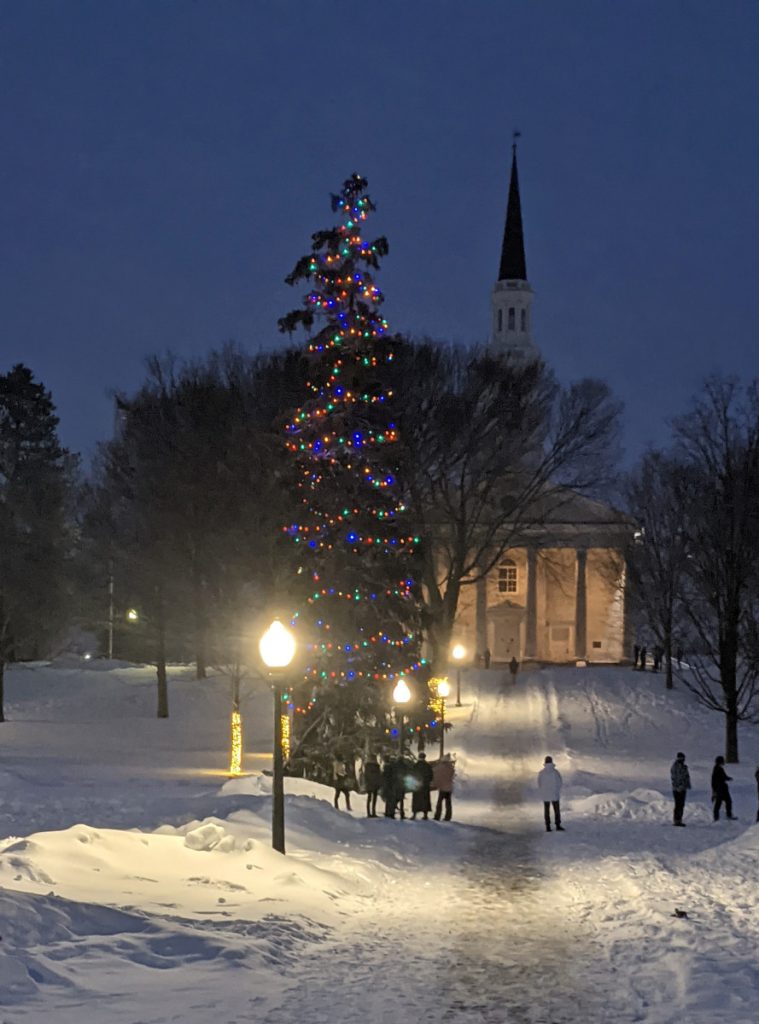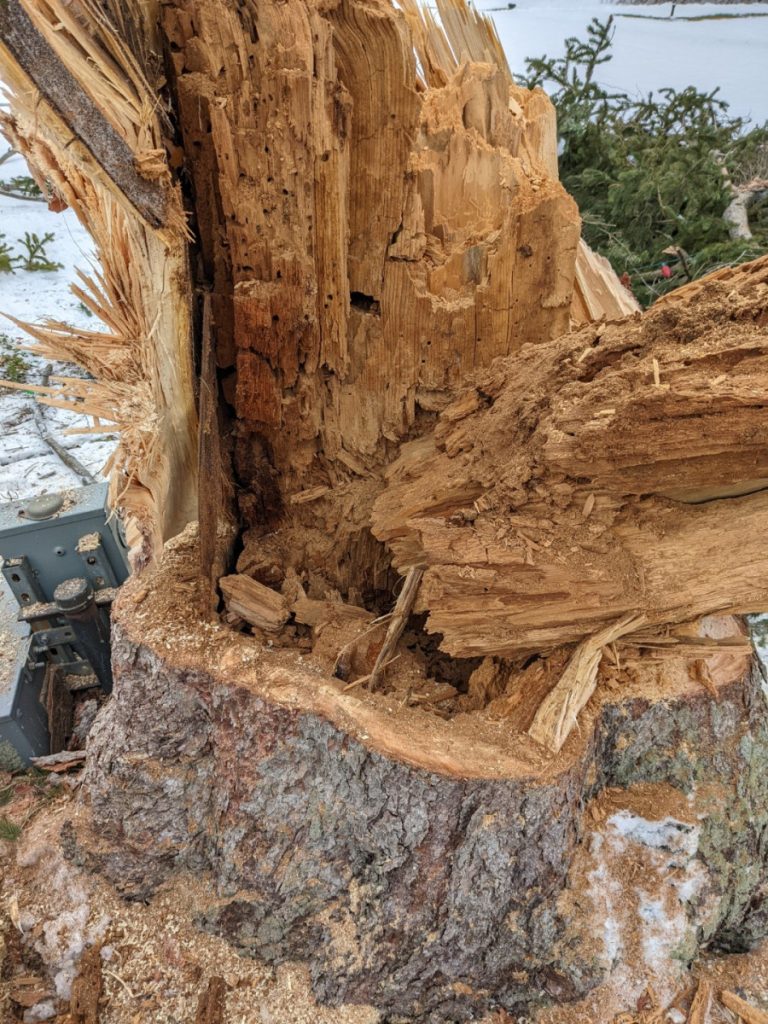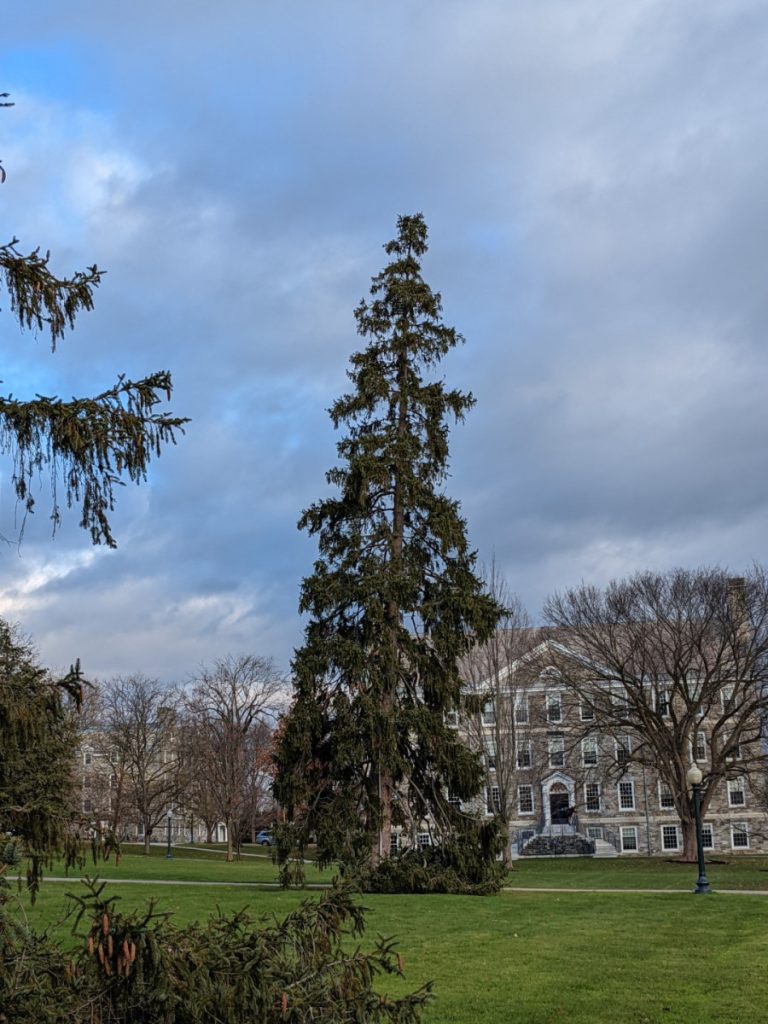Trees do everything relatively slowly-germinate, grow, live, even die slowly, sometimes taking decades. Arborists speak of a ‘mortality spiral’-when a tree suffers a series of compounding minor injustices and slowly declines until it’s eventual, and often undramatic, death. Owing to this tree time, in arboriculture there are very few red flag moments, those ‘drop everything and deal with this problem’ panics. Most of mine tend to be trees that have fallen across roads or fire lanes. Recently, we removed the Holiday lighted tree from the center of the main quad, having found a major red flag.
The Lighted tree was a Norway spruce, located next to Storrs Walk on the way up to the Chapel. There are only a couple of spruce left, but in past years they had formed a line on either side of the quad north of the McCullough Gymnasium, making a border and windbreak to what was athletic fields and are now our quad.
Film approximately 1930, thanks to Middlebury Special Collections- https://archive.org/details/middfilms_ff098 .

Norway spruce is a widely planted fast growing tree, native to northern and central Europe. They tend to live about 300-400 years in their native range and grow 60-80’ tall. The branches rise and ascend at the upper levels of the tree canopy, but gracefully swoop and hang down at lower levels. This is thought to aid in shedding snow in northern climes, but also lend a grace and beauty to the tree. Their fast growth and evergreen status make them a very popular landscape tree, and the wood is prized for its excellent tone in stringed instruments. We have many large specimens scattered on all corners of our campus.
This tree has had lights on it since forever. It’s a pretty good slug of work yearly to keep lit, as the squirrels on campus seem to love chewing the wires. One of our landscape workers was doing a safety check of the tree before replacing some of the lights when he noticed holes in the ground at the base of the tree. He called me over to inspect, and I ambled over.
We keep a close eye on all our trees, but some more than others. Probably 20-30 are on a list of ‘risk’ trees that we inspect yearly, most often older specimens in prominent locations. The lighted tree was not on this list. It has been in poor health for the last 15 years I’ve been here, in part due to location. Much of the root system near the base of the tree is covered in concrete sidewalk. Looking at the crown of the tree the poor growth rate was evident-little new shoot activity and a thin crown with few branches. But not all trees have to be perfect, just safe.
The holes around the root flare were indeed concerning, there were multiple locations where clearly a chipmunk or something had burrowed underneath the root flare. This was not the red flag, though. The excavation did not seem to be recent, and was not accompanied by mounds and mounds of dirt around the holes. I took a small tool and tapped on the trunk, usually my next step after inspecting the root flare.
As I suspected, it sounded hollow, a low thunky sound that’s hard to describe. Healthy wood has a solid ringing sound, like it’s proud of its strength, a low muted thump is usually the sign of rotten wood, a loud drum beat means it’s hollow. Taking a drill with a long but very narrow drill bit I probed several locations on the trunk. The drill enters live wood slow and needs quite a bit of pressure to do down into the trunk, but on soft, rotten wood encounters no resistance at all. I discovered about 1” of live wood before drilling through what was clearly rot. I drilled up about 5’ and found it was a column of decay from the base right up through the main part of the trunk. Probing and drilling around the root flare didn’t seem to indicate decay.
This is called a heart rot-the heartwood of the tree being attacked and decomposed by fungi, in this case probably Phellinus pini.Not the red flag though! Picture an old brick building, it’s interior walls long gone, but the solid outer walls holding strong for years. A tree can be hollow and still be strong, or at least strong enough to stay upright. Heart rot breaks down lignin, the structural cell component that makes wood strong and able to bear weight. Of more concern are usually sap rots, fungal species that break down cellulose in cell walls and compromises the flexibility of trees.
The red flag appeared as I walked up to the tree right at the very beginning, although I wasn’t sure. It seemed to me like the tree developed a lean, about 3 degrees towards the east, now appearing to loom subtlety but menacingly over the north/south sidewalk. I wasn’t sure, though. Looking at the ground next to the trunk it appeared slightly heaved up on the west side, but not dramatically so.
A persistent tree myth concerns roots. Roots don’t go deep, certainly not as deep as the tree is tall, and very rarely do trees have a true taproot. Instead, most tree roots are found within the top foot of soil, extending out past the crown of the tree. Most trees will send sinker roots down from those lateral roots, driving about 2-3 feet down, like a tent stake. Norway spruce, however, don’t grow a lot of sinker roots, and as a species tend to be prone to tipping over, particularly in clay soils or high wind locations.
We have both here, high winds from the west coming downslope, and a heavy clay soil prone to seasonal moisture at the base of the ledge. Remember the soil was heaved on the west, and we also noticed a crack in the trunk. Clearly, something was moving around here. The technical, and scary sounding name is Root Plate Failure, and it’s a big deal. Trees can be hard to define, but I prefer the concept of them being a large woody plant that if it falls on you will kill you. Root plate failure means the tree has lost its support and can fall. Seeing ground heaved up next to the trunk means recent and dramatic failure, and for organisms that do everything slowly root plate failure is lightning speed in tree time.
Trees need three items to be considered a risk tree, here we have all three. One, a part that could fail (the roots), second, a mechanism for failure (wind, upcoming winter snow load), and three, most importantly, a target. The sidewalks, the fire pits, tent out in the quad, all this means many people walking around, a classic ‘target rich environment’.
It is, however, the lighted tree. All trees deserve thoughtful consideration before removal, but iconic trees in prominent locations up the ante. Giving it every chance we could, we did an old fashioned pull test. Sounds fancier than it is-tie a rope most the way up the tree on the trunk, stand way back, and have a couple people pull, simulating a windstorm. A couple people pulled towards Old Chapel, and I stood at the base of the tree and felt the trunk and ground. Sure enough, the ground beneath me moved, and the entire trunk flexed all the way to the base. This was enough of a red flag I started calling every manager/director/vice president I could reach while we had the rope in the tree, as this was best experienced live.
The International Society of Arboriculture certifies arborists in Tree Risk Assessment, and I usually run through the process before any removals. I feel like we owe it to the tree. Following standard Tree Risk Assessment protocols, with high consequences of failure and a somewhat likelihood of failure and impact I determined this tree presented moderate to high risk.
Mitigation options other than removal are non-existent. Tree based interventions, such as preventing wind throw by bracing or crown thinning are contraindicated in both the species and this tree, and there are no treatments for heart rot with such advanced decay. Given the high activity near the tree with the tent, fire pits, et.al, site-based interventions such as moving pedestrians or restricting access is not possible. Sadly, given the level of risk remaining, we felt like the tree should be removed. We waited until holiday break, to not make a lot of noise during final exams.



